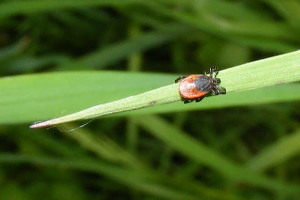Look out for Ticks
This week we took our first tick of the year off Jessie so that provided an appropriate reminder that it's time we warned everyone about them again. Ticks are small, spider-like creatures that feed on the blood of animals, including people.

The size of a tick varies, depending on the stage of its life cycle, gender, species and whether it has fed recently. Nymphs are about the size of a poppy seed, while adult ticks look more like tiny spiders.
Ticks can survive in many places, but prefer moist areas with dense vegetation or long grass. The species of tick most frequently found on people is Ixodes ricinus, more commonly known as the sheep or deer tick. They are usually found in woodlands, grassland, moorland, heathland and some urban parks and gardens.

Ticks don't jump or fly, but wait until an animal or person brushes past to climb on. They then bite to attach to the skin and start to feed on blood. It may take several days to complete their blood meal, before they drop off.
Ticks can be found throughout the year, but are most active between spring and autumn. They can transmit bacteria that cause diseases such as Lyme disease, which can lead to very serious conditions if left untreated. Symptoms of Lyme disease can include flu-like symptoms, fatigue, muscle and joint pain.
Lyme disease can be treated with a course of antibiotics. Without treatment, more serious conditions such as viral-like meningitis, facial palsy, nerve damage and arthritis can develop, so prevention and early detection are crucial.
We have a page with lots more information about ticks, including how to find them and how to remove them and we would recommend reading it before you or your dogs head out into the countryside.
You can comment on this post in our forum.
Participants in these activities should be aware of and accept these risks and be responsible for their own actions.